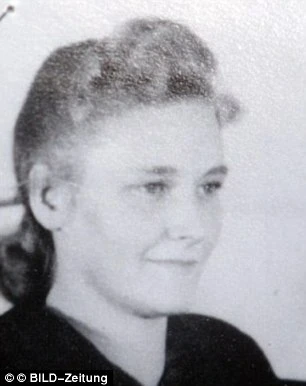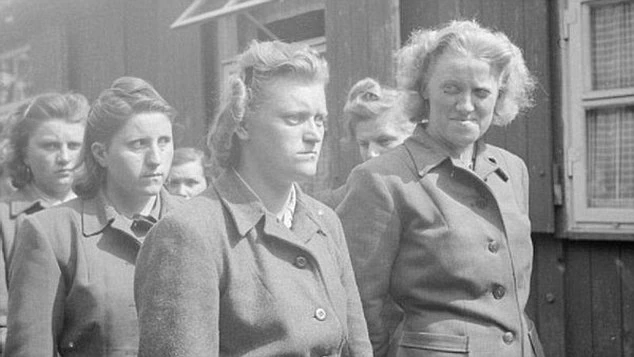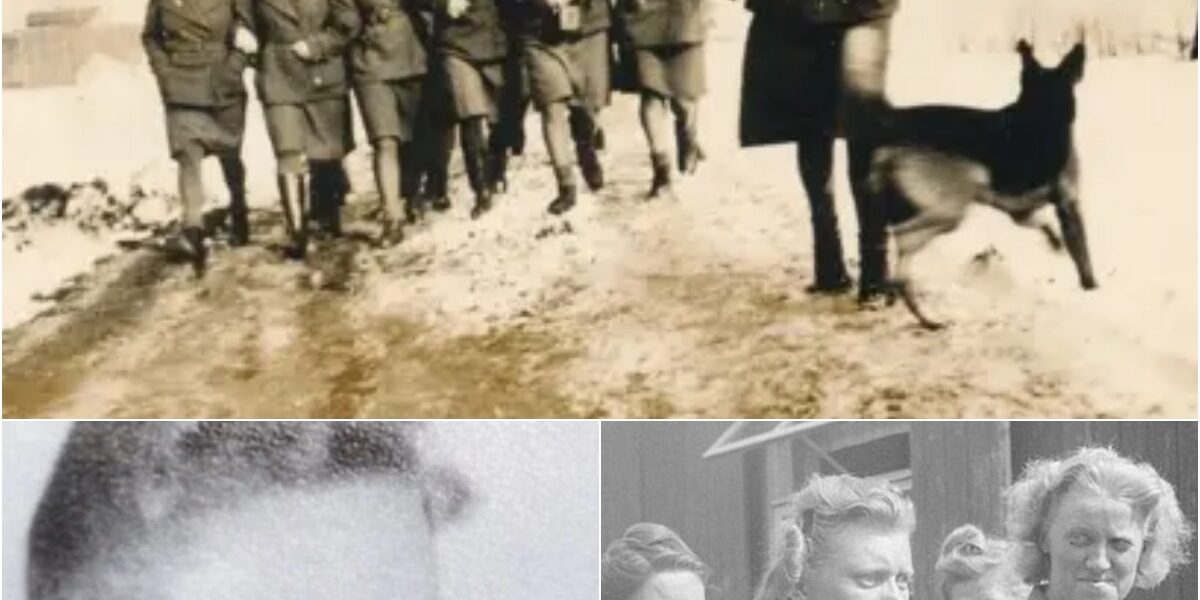HELL’S ANGEL: The Chilling Story of Charlotte S – The Nazi Camp Guard Who Fed Prisoners to Dogs
The horrors of the Nazi concentration camps during World War II remain a haunting chapter in history, with stories of unimaginable cruelty still emerging decades later. Among the 3,700 women who served as guards in these camps, only three faced justice for their roles in mass murder. One such figure is Charlotte S, a notorious female guard at Ravensbrück and Auschwitz, whose chilling actions—beating prisoners and unleashing her ferocious dog—left an indelible mark on survivors. As reported by the Daily Mail, Charlotte’s story is a stark reminder of the depths of human cruelty and the elusive nature of justice. How did someone so deeply complicit evade significant accountability, and what does her story reveal about the broader legacy of Nazi war crimes? Let’s delve into this dark history and uncover the truth behind Charlotte S.

Portrait of female prison warden Charlotte S. Photo: Bild.
Charlotte S’s story is a disturbing glimpse into the machinery of the Nazi regime, where ordinary individuals became instruments of terror. As a female guard at Ravensbrück and later Auschwitz, she embodied the cruelty that defined these camps. With only three out of 3,700 female guards prosecuted for their roles in mass murder, Charlotte’s case raises questions about accountability, the role of women in Nazi atrocities, and the lasting impact on survivors. Let’s explore her actions, the context of her crimes, the justice she faced, and the broader implications of her story.
Charlotte S: The Face of Cruelty at Ravensbrück
Charlotte S served as a guard at Ravensbrück, a women’s concentration camp in northern Germany, where over 130,000 prisoners—mostly women and children—endured unimaginable suffering. Survivors describe her as a terrifying figure, her “gentle smile” masking a sadistic nature. According to a survivor’s account in the Daily Mail, Charlotte was “thin and had a ferocious dog always ready to bite prisoners.” She enforced brutal punishments, forcing prisoners to stand for hours in extreme weather—scorching heat or freezing cold. “If anyone moved, she would unleash the dog. Many couldn’t survive its bites,” the survivor recalled. These acts of violence, including beatings and allowing her dog to “devour” prisoners, cemented Charlotte’s reputation as a merciless enforcer of Nazi terror.
Her cruelty wasn’t limited to physical violence. The psychological torment of her unpredictable behavior—smiling one moment, unleashing horror the next—added to the prisoners’ suffering. Ravensbrück was notorious for medical experiments, forced labor, and mass executions, and Charlotte’s role as a guard made her complicit in these atrocities. Her actions reflect the broader role of female guards, or Aufseherinnen, who were integral to the camp’s operations, overseeing prisoners and enforcing the regime’s brutal policies. Posts on X echo the survivors’ horror, with one user stating, “Charlotte S’s story is chilling. How could someone hide such evil behind a smile?”

Of the 3,700 women who worked at Nazi concentration camps during World War II, only three faced justice.
From Ravensbrück to Auschwitz: A Trail of Terror
In 1943, Charlotte S transferred to Auschwitz, the epicenter of the Holocaust, where over 1.1 million people were murdered. Her tenure there was marked by a scandalous affair with an SS officer, highlighting the complex dynamics within the Nazi hierarchy. This relationship led to her pregnancy, prompting her to leave her role as a guard that same year. While her time at Auschwitz was shorter, the camp’s scale of horror—gas chambers, crematoria, and systematic extermination—meant even a brief stint implicated her in one of history’s greatest atrocities. Her involvement in both camps underscores the extent of her complicity, as she actively participated in the machinery of death at two of the most infamous sites of the Holocaust.
The role of female guards like Charlotte was critical to the Nazi system. Unlike male SS officers, who often held higher ranks, female guards directly managed prisoners, enforcing discipline through violence and fear. Their proximity to victims made their actions deeply personal, amplifying the trauma for survivors. Charlotte’s affair with an SS officer also sheds light on the blurred lines between personal and professional conduct in the camps, where power dynamics fueled both cruelty and corruption. An X user remarked, “Female guards like Charlotte S were just as brutal as the men. Their stories deserve more scrutiny.”
A Meager Reckoning: Justice After the War

After World War II, the pursuit of justice for Nazi war criminals was uneven, particularly for female guards. Of the 3,700 women who served in concentration camps, only three faced charges specifically for complicity in mass murder. Charlotte S was convicted of “mistreatment and theft,” receiving a mere 15-month sentence—a strikingly lenient punishment given the scale of her crimes. The Daily Mail notes that at 94, Charlotte still lives in Germany, refusing to discuss her past. This silence is emblematic of many former Nazi collaborators who evaded accountability, living out their lives without fully confronting their actions.
The leniency of Charlotte’s sentence reflects broader challenges in post-war justice. The Nuremberg Trials and subsequent proceedings focused primarily on high-ranking Nazi officials, leaving many lower-level perpetrators—like female guards—under-scrutinized. Limited evidence, survivor trauma, and the sheer scale of Nazi crimes made prosecuting every individual difficult. Charlotte’s case highlights a systemic failure to hold all perpetrators accountable, particularly women, whose roles were often downplayed as “lesser” compared to male SS officers. An X post captured the frustration: “15 months for such cruelty? Justice was barely served for Charlotte S and others like her.”
The Broader Legacy: Women in the Nazi Machine
Charlotte S’s story raises critical questions about the role of women in the Nazi regime and the complexities of accountability. Female guards were not passive bystanders; they were active participants, often as brutal as their male counterparts. Their recruitment—often young, working-class women drawn by stable jobs and authority—reveals how the Nazi system co-opted ordinary individuals into its genocidal machinery. Charlotte’s ability to blend back into society post-war, living to 94 without further reckoning, underscores the challenges of addressing complicity on a societal level.
Survivors’ testimonies, like those quoted in the Daily Mail, are vital to preserving the memory of these atrocities. They remind us of the human cost of the Holocaust and the need for continued vigilance against such horrors. The fact that only three female guards faced justice for mass murder highlights a gap in historical accountability, prompting debates about how societies confront their past. As one X user put it, “Stories like Charlotte S’s show why we must keep telling these histories—to ensure justice, even decades later.”
Charlotte S’s story is a haunting reminder of the cruelty that thrived in Nazi concentration camps and the incomplete pursuit of justice that followed. Her actions at Ravensbrück and Auschwitz—beating prisoners, unleashing her dog, and enforcing terror—mark her as a key figure in the Holocaust’s horrors, yet her 15-month sentence reflects a broader failure to hold all perpetrators accountable. As one of only three female guards prosecuted for mass murder among 3,700, Charlotte’s case underscores the complexities of confronting complicity. Her silence at 94 leaves unanswered questions, but survivors’ voices ensure her crimes are not forgotten. What do you think—how should history judge figures like Charlotte S, and how can we ensure justice for such atrocities?




